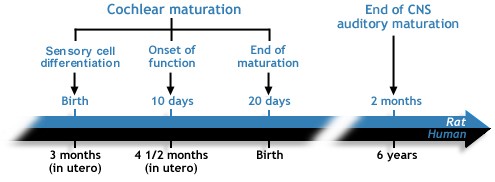Development and plasticity
Authors: Rémy Pujol
Contributors: Sam Irving
Whilst the human cochlea has completed its development by birth, the brain’s auditory pathways and centres develop more slowly and progressively, from the brain stem to the auditory cortex.
Table I: timing of maturation of the organ of Corti in different species
This table gives comparative timings of stages 2 (onset of hair cell morphological differentiation), stage 4 (onset of cochlear potentials), and stage 5 (end of maturation) in different mammals (see next page).
wg = weeks of gestation (humans) ; ed = embryonic days ; pnd = postnatal days
|
Espèces |
Stade 2 |
Stade 4 |
Stade 5 |
|
Human |
10 wg | 18 wg | 30 wg |
|
Rat, Mouse |
16-17 ed | 8-10 pnd | 16-20 pnd |
|
Cat |
? (ed) | 3 pnd | 20 pnd |
|
Guinea-Pig |
34 ed | 54 ed | 6 pnd |
|
Gerbil |
? (ed) | 12 pnd |
20 pnd |
Table II: comparative development of the cochlea and the auditory brain in both humans and rats

This table recalls stages 2,4, and 5 (see above) of cochlear maturation and highlights the late development of the auditory brain.
Actually, to mature properly, the brain requires the cochlea to be fully mature and functional. An early detection and rehabilitation of a peripheral (ear) impairment is thus essential !